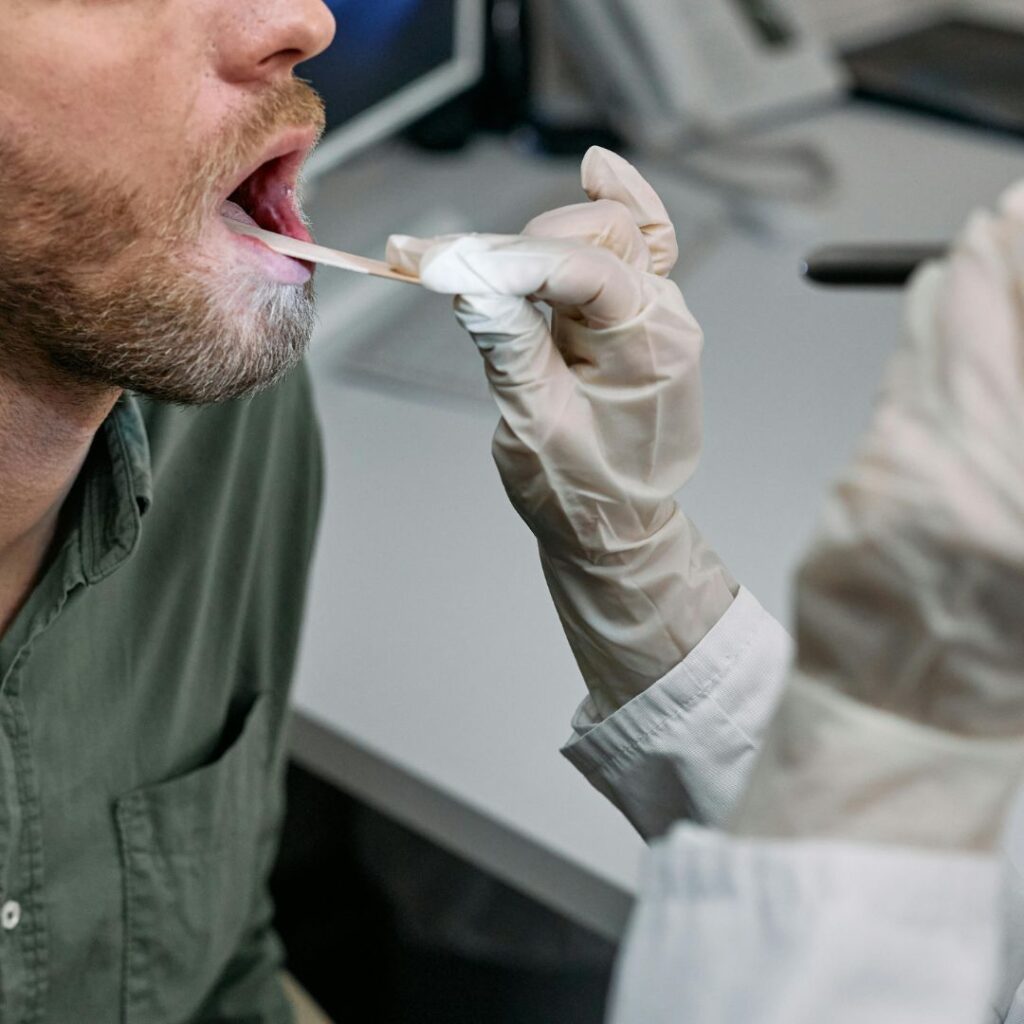Epipharyngeal Abrasive Therapy (EAT)
A Long COVID Breakthrough: Science-backed relief from Long COVID—trusted by leading Japanese health professionals

Frustration Ends Here
If the lingering symptoms of Long COVID, chronic fatigue, or unrelenting brain fog have been an unwelcome guest to your everyday life.
You’re not alone.
As you well know, these debilitating symptoms can persist, leaving you searching for answers.
Maybe often wondering, “What’s wrong with me?”
For many people, relief is no longer a dream.
Epipharyngeal Abrasive Therapy (EAT) is a groundbreaking treatment targeting inflammation and immune dysfunction, addressing root causes of Long COVID symptoms like persistent sore throat, difficulty concentrating or remembering (brain fog), and profound exhaustion even after rest (chronic fatigue).
What is Epipharyngeal Abrasive Therapy?
EAT is an innovative, minimally invasive procedure which involves:
- Gentle massaging: Using a zinc solution applied with a cotton swab to the inflamed mucosa in the epipharynx is gently massaged. This process consists of a gentle abrasion of the epipharyngeal (throat) lining to stimulate healing, reduce inflammation, and decrease the production of neuroexcitatory molecules
- Vagus nerve stimulation: The procedure directly stimulates the vagus nerve, which plays a key role in regulating autonomic functions and reducing systemic inflammation.
- Cytokine suppression: Clinical research indicates that EAT can lower inflammatory cytokines levels such as IL-6 and TNF-alpha, which are associated with immune dysregulation and chronic fatigue.
Additionally, EAT may stimulate the vagus nerve, which plays a crucial role in calming the body’s stress responses and aiding in the recovery of energy levels, mental clarity, and overall balance.

Who Can Benefit from EAT?
While chronic epipharyngitis can sometimes present without obvious symptoms, EAT is ideal for patients experiencing issues such as:
- Pressure headaches or persistent headaches not responding to usual treatments
- Persistent sore throat, postnasal drip, or runny nose.
- Irritated throat, cough, hoarseness, change in voice, difficulty swallowing, or nasal congestion.
- Dizziness, vertigo, or balance issues.
- Hearing difficulties, tinnitus, or eustachian tube dysfunction.
- Fatigue, difficulty concentrating (brain fog), and mood disturbances.
- Snoring, insomnia, daytime sleepiness
- Acid reflux, heartburn
What to Expect During Treatement
EAT is performed in-office, typically takes only 10-15 minutes so you’re home the same day. Here’s what you can expect:
- Initial Evaluation: Endoscopic imaging is used to confirm inflammation in the epipharynx.
- The Treatment: A sterile cotton swab soaked in zinc is rubbed to the inflamed area, creating a temporary “whitening effect” that indicates reduced inflammation.
- Recovery: Some patients may experience mild soreness or a scratchy throat, which resolves quickly.
Safety: Backed by decades of Japanese clinical use, EAT has minimal risks and a strong safety profile.


Personalized Care with Dr. Groysman
At Covid Institute, we know every patient’s experience with Long COVID is unique.
This is why Dr. Groysman develops personalized treatment plans tailored to your unique symptoms, which may include:
- Epipharyngeal Abrasive Therapy (EAT) as a primary intervention.
- Supplementation and prescription medications to enhance recovery.
- Complementary therapies to address systemic inflammation, which may include SGB (or Stellate Ganglion Block).
“85% of our patients report marked improvement within the first few sessions. This is based on our own clinical observations conducted in our clinic, not an actual clinical trial.”
Patient Success Stories
Dr. Groysman, you are amazing and after getting SGB (both sides) and one EAT, I’ve been continually recovering over the past 5 months. I got LC in March, 2020 and had tremendous fatigue, mostly bed bound, which ruined my life. My immune system was non-existant. – AEB 12/2024
Update: My daughter is a singer and worked with her voice coach yesterday for the first time since her SGB and EAT 2 weeks ago. I got this message from her voice coach today: “I’m so excited to see where these treatments take her. Her voice is already coming back to the way it was. I know it’s hard to tell for you guys probably, but when she started with all of this her range dropped, became super airy in her tone, breath support etc. Yesterday there was already so much more tone!” – J.L. 8/2024
Thank you Dr. Robert for being one big step on my son’s recovery. Today he finally back to his normal happy and energetic, can get up at 7 and go to his hobby Robotics club. It was 39 months journey with more than 50 doctors/therapists. The EAT procedures were able to rid of all the focal inflammation , so he was able to further progress to get rid of the POTS PEM and chronic fatigue. Merry Christmas to you and your team , and all people here ! Do not give up , human body are so magic , we should all be able to heal ! – SS 12/2024
EAT Procedure FAQ's
Right now, Dr. Groysman is the only physician outside of Japan that offers this procedure on a regular basis.
In general it takes 10-15 minutes to complete the procedure. It takes a few extra minutes to numb up the back of the nose.
We numb the inside of the nose using a topical numbing spray that has lidocaine. The procedure is well tolerated awake by most.
The size of the nostrils doesn’t actually matter. The flexible endoscope camera is 3.8 mm and can fit thru the narrowest of nostrils.
Yes, even kids tolerate this procedure awake. If sedation is required, we can call something oral in before the procedure.
Yes you can have both procedures done on the same day, just not at the same time.
Yes. Its preferable to wait 1-2 weeks after recovering from a cold, flu or COVID before having the EAT procedure.
It may be repeated as many times as needed.
It does not. There is no CPT code to bill even for this procedure.
You can. We can call in an oral sedative for you to take 30 minutes before the procedure. You will still be awake but more relaxed for those that tend to be anxious.
Nothing specific is needed. If you have seasonal or respiration allergies, take your usual medications.
It has 4 mechanisms that work:
- direct cleaning from abrasion – kind of spring cleaning of the back of your nose and throat.
- stimulation of the vagus nerve endings
- decreased inflammatory cytokines
- improved dysautonomia symptoms
You may experience some discomfort of burning in the back of your nose. The amount depends on how inflamed your epipharynx is. Soreness typically lasts for 1-2 days after the procedure. One idea to reduce this is to use a regular saline nasal spray and gargling with a 1/2 teaspoon of salt dissolved in warm water.
It will treat any ENT problems such as pressure headaches, face pain, stuffy nose, post nasal drip, as well as those caused by dysautonomia. It may also help with CFS/ME. Dr. Groysman believes that the EAT procedure works synergistically with the SGB procedure. It can treat the missing gaps that SGB misses.
It all depends on how inflamed the epipharynx is initially. Some will d o fine with 1-2. Others will need 4 or more.
In general, Dr. Groysman recommends waiting 5-7 days between procedures to allow the epipharyngeal area to heal between treatments.
Take Control of Your Recovery
If you’re tired of living with Long COVID symptoms, Epipharyngeal Abrasive Therapy may be the solution you’ve been seeking.
Schedule a consultation today to learn more about this innovative treatment and how Dr. Groysman can help you recover.
Relief is within reach. Take the first step today.
References and Additional Reading
EAT is supported by studies showing: